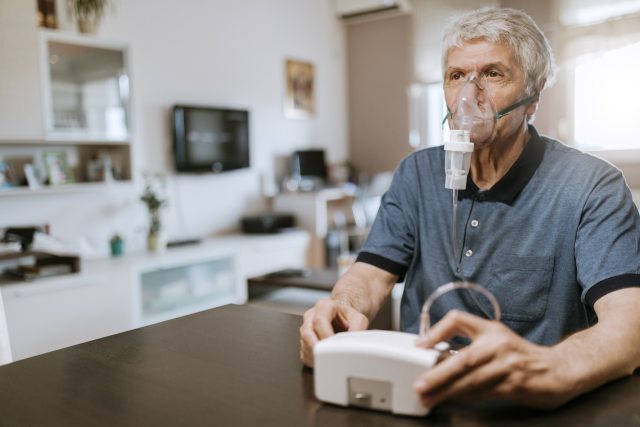How to keep your lungs healthy
| Healthy You | Wellness

Smokers aren't the only ones affected by lung cancer. Here’s what you need to know.
Did you know lung cancer is the second-most common type of cancer, behind breast cancer in women and prostate cancer in men?
It is estimated that nearly 130,000 Americans will die from lung cancer in 2022. That’s about 27% of all cancer deaths — more than breast, prostate, colorectal, kidney, and melanoma cancers combined.
About 20% of people who die from lung cancer never smoked.
“Lung cancer is not just a smoker’s disease,” said Bhanu Patibandla, MD, a pulmonary disease specialist at PeaceHealth in Vancouver, Washington.
While it’s true smoking tobacco is the leading cause of lung cancer, according to the American Cancer Society, there are several other factors that can cause lung cancer, said Dr. Patibandla.
“It’s important that people know about these and take steps to keep their lungs healthy.”
All smoking is bad
It might be obvious, but it should be said that all smoking is unhealthy, he said. Here’s how different types of smoking raises an average person’s risk for lung cancer:
- Cigarettes: increases your risk 20 times
- Cigar/pipe: increases your risk 5 times
- Secondhand smoke: increases your risk 1.34 times
Why smoking is so bad
Smoking draws thousands of harmful chemicals into the lungs. Tar and toxins are left behind, trapped in the lung tissue. And over time, those harmful chemicals make healthy cells weaker causing lung disease such as COPD and transform normal cells into cancer cells leading to lung cancer, said Dr. Patibandla.
When it comes to smoking marijuana, there isn’t clear evidence that it causes cancer, according to the National Institutes of Health. However, marijuana does contain some of the same harmful chemicals as tobacco and sometimes more. Also, because people inhale marijuana smoke more deeply and hold it for longer, much more tar and toxins can be deposited in the lungs.
Similarly, there isn’t enough data right now to show vaping as a cause of lung cancer. But studies prove vaping causes other serious lung issues such as bronchitis (swelling of the airways/breathing tubes), pneumonia and collapsed lung. Dr. Patibandla urges patients to avoid smoking of all kinds.
It’s never too late to give up smoking. Read more about the positive difference felt in just a few days after quitting. Quitting smoking is the best thing you can do—not only for the health of your lungs, but for the health of your entire body. Read more on how to quit smoking.
Other causes of lung cancer
Following are the other most common factors known to cause lung cancer:
- Breathing in or being around
- Radon, a gas emitted from the ground that can’t be seen, smelled or tasted. Learn about radon levels in your area.
- Asbestos, a material used in buildings. Read where asbestos is commonly found.
- Elements such as silica, arsenic and nickel¬ found in work-site settings.
- Air pollution, such as smoke in the air. Check current air quality for your zip code.
- Family history and inherited genes
- Other lung diseases such as chronic obstructive pulmonary disease (COPD) and pulmonary fibrosis
- Radiation treatment to the chest
Why lung cancer is so deadly
Lung cancer in its early stages does not usually cause any symptoms. By the time symptoms show up, it is usually widespread, and the treatment options can have limited success.
“About two out of three lung cancers are diagnosed at advanced stages. That’s why screening is so important,” Dr. Patibandla emphasized. “Lung cancer screening allows us to detect cancer much earlier, when we can cure it.”
“Screening rates for lung cancer are extremely disappointing. Less than 10% of people who are eligible get screened for lung cancer,” he noted. “We can improve lung cancer outcomes by catching it early. And screening is the best way to do that.”
Lung cancer screening saves lives
Screening for lung cancer reduces the risk of dying from the disease by at least 20% for those at high risk for lung cancer. Experts say an estimated 15 million people in the US would potentially benefit from lung cancer screening.
Lung cancer screening is recommended for people:
- 50-80 years of age
- Currently smoking or quit in the last 15 years
- With 20 pack-years (e.g., smoking 1 pack of cigarettes per day for 20 years or 2 packs/per day for 10 years)
The screening itself is done with a low-dose CT scan, which uses only 20% of radiation compared to regular CT scans.
Patients don’t have to do anything ahead of time to prepare for the scan; they will need to lie still on a table as the scanner moves around the body. Lung cancer screening takes about 10 minutes with the actual scanning time only a few seconds. For more information on this, watch this video.
These screening exams are covered by Medicare, Medicaid and most insurance plans. (Note: some insurance covers the exam up to age 77.) For those at high risk for lung cancer, the screening should be done every year. Learn more about lung screenings.
“Because of the pandemic, many people have not had their lung cancer screening,” says Andrea Arnett, MD, radiation oncologist at PeaceHealth St. Joseph Cancer Center in Bellingham, Washington. “We’re seeing patients now that have more advanced-stage cancers that are harder to treat. Please talk with your doctor about getting screened.”
Better tools to find and treat lung cancer
While it’s scary for people to find out they have lung cancer, the good news is that there are newer tools and better equipment now available to help doctors find and treat it, according to Katsu Nishida, MD, a pulmonary physician with Oregon Lung Specialists who cares for people at PeaceHealth in Springfield, Oregon.
Physicians there are using advanced technology to help find and treat nodules in the lung. “This technology can locate even hard-to-reach small nodules in the outermost branches of the lungs and diagnose lung cancer at early stage. Early-stage lung cancer has a much higher cure rate,” said Dr. Nishida. It has made a life-saving difference for 119 patients so far. It is one of only two programs on the entire West Coast using the technology for real-time evidenced-based biopsy. (See how Monarch, an advanced/robotic bronchoscope, works.)
Similarly, PeaceHealth’s Lung Nodule and Thoracic Oncology program in Vancouver, Washington also uses robotic bronchoscopy that allows physicians to offer diagnosis and treatment in the same day rather than the traditional step-wise approach. In addition, robotic bronchoscopy is extremely helpful when performing surgery for small, early cancers while trying to preserve patients’ lung tissue, according to Svetlana Kotova, MD, a thoracic surgeon in the program.
At PeaceHealth St. Joseph Cancer Center, Dr. Arnett and her colleagues use technology called a TrueBeam Linear Accelerator that allows them to treat lung cancer using precise radiation, which is especially useful for people who are not able to undergo surgery to remove the tumor.
All three programs offer much-needed hope in this critical area. “We are all in this fight against lung cancer together,” said Dr. Nishida.
Steps to keep lungs healthy
Lung cancer is more common than people think. If caught early, it is treatable — but more importantly, it is largely preventable.
What can you do to keep your lungs healthy?
“Because so many risk factors have nothing to do with smoking, it’s a good idea to find out if you might have been near or affected by some of the substances known to cause lung cancer and then take steps to reduce their effect,” said Dr. Patibandla.
And it’s not just avoiding things that are bad for lung health, he said.
Here are some active steps you can take to keep or improve your lung health, including:
- Get regular exercise. Aerobic exercise (the kind that makes your heart beat faster) isn’t only good for muscles and bones. It also helps your lungs move air effectively into and through the body. Oxygen is essential for good overall health.
- Drink 8 cups of water per day. Hydration helps keep the lining of the airways moist, which helps expel or get rid of harmful things that are breathed in.
- Try steam. Breathing clean steam can open airways, keep the lining of the airways moist and decrease the chance of infections.
- Drink green tea. Green tea may help reduce inflammation in the body, including the lungs.
- Eat a nutritious diet. Veggies, fruits, good fats and other healthy food help decrease inflammation in the body, including the lungs.
- Wear a mask. If conditions in your workplace are harmful to the lungs, wear a mask that keeps chemicals and other harmful substances from entering your lungs.
Bhanu K. Patibandla MD
Bhanu K. Patibandla MD practices Internal Medicine in Vancouver.






